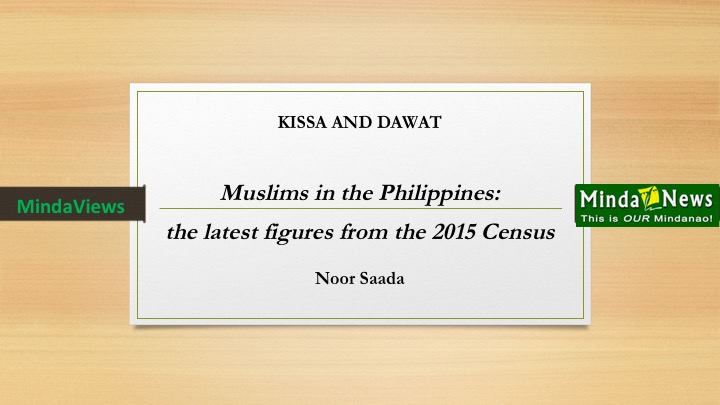
I bumped into Abubakar Asaad at the NAIA Terminal 3 several weeks ago. He is a respected Sama professor who spent sometime in the University of the Philippines before joining the newly-organized Philippine Statistics Authority (PSA)[1] as a provincial director.
As I was doing on-call consultancy for the Department of Education (DepEd) on Muslim Education Program (MEP), I mentioned to him a need for Muslim statistics – where are the Muslims in the Philippines. One prevailing misconception is that Muslims are in Mindanao only. How happy I was when Prof Asaad told me that the 2015 Census of Population (2015 PopCen) is available to the public.
In the latest PSA press release[2], the Philippine population had surpassed the 100 million-mark and annually we increase by “17 persons per year for every 1,000 persons.” More than half (56.9 percent) of the country’s population are in Luzon, followed by Mindanao (23.9 percent) and the Visayas (19.2 percent). Sex-wise, “of the total population, 50.6 percent was male while 49.4 percent was female. This resulted in a sex ratio of 102 males for every 100 females. The same sex ratio was reported in 2010.”
Against this brief national backdrop where are the Muslims?
We start in Mindanao. In the PSA-ARMM Fact Sheet July 26, 2017, “Mindanao had a total population of more than 24 million as of August 1, 2015.” Of this number, 5,646,010 are Muslims. Meaning, for every ten Mindanawons, two are Muslims.
While the bulk of the 5.6 million-plus Muslims are in the Autonomous Region in Muslim Mindanao (ARMM) with 3,445,248; this is followed by Region XII (Central Mindanao) with 1,032,824, and Region IX (Zamboanga Peninsula) with 603,289, Region X (Northern Mindanao) with 378,019 and Region X (Davao Region) with 167,879. Mindanao-wide, Caraga has the smallest Muslim population with only 12,355 inhabitants.
After Mindanao, there are more Muslims in Luzon than in the Visayas.
“Less than 1 percent of the total population of Luzon were Muslims”[3]. The Muslim in Luzon[4] are concentrated in the National Capital Region (NCR) with 154,840 inhabitants, followed by Region IV-A (Calabarzon) with 67,983 Muslims; Region III (Central Luzon)with 39,202; Region I (Ilocos) with 10,801; Region II (Cagayan Valley) with 6,525; and Cordillera Administrative Region (CAR) with 4,679 Muslim. Officially based on the 2015 Census, Muslims can now be found in all Luzon provinces except Batanes.
“Only 0.15 percent of the total population of Visayas were Muslims.”[5] The largest Muslim concentration is in Region VII (Central Visayas) with 12,167 inhabitants, followed by Region VIII (Eastern Visayas) with 5,681 Muslims, the Negros Island Region with 5,276 Muslims and Region VI (Western Visayas) has the least number of Muslims with 5,138. All the provinces and major cities have Muslim inhabitants.
What are the implications of this data?
It belies the stereotype that Muslims are only in Mindanao. Muslims are now thriving and integrated across the Philippine archipelago. There is a moral obligation for those living outside of the traditional Muslim area to be model of their Muslim identify and heritage. This way, the daily interaction with non-Muslims help to gradually remove the stereotypes against each other.
In view of the DepEd’s Muslim Education Program (MEP), we can now compare the current enrollees with the census and able to determine gaps. We can now have targetted expansion and new programming.
Also, this data will inform government decision as to the addditional establishment and organization of Shari’ah courts as mandated by Presidential Decree 1083 or the “Code of Muslim Personal Laws of the Philippines”[6].
These are just sample utility of census data. I do hope that there is a growing realization of its importance to human and community development among Muslims.
Census is a much a political as it is a development tool. I hope fellow Muslims will sway to the latter. There are those who complain that government and non-government interventions are not sharp enough to address Muslim needs. Maybe as a community we were and are not proactive in participating in the census. Census builds the foundation of our development and political influence.
(MindaViews is the opinion section of MindaNews. Noor Saada is a Tausug of mixed ancestry – born in Jolo, Sulu, grew up in Tawi-tawi, studied in Zamboanga and worked in Davao, Makati and Cotabato. He is a development worker and peace advocate, former Assistant Regional Secretary of the Department of Education in the Autonomous Region in Muslim Mindanao, currently working as an independent consultant and is a member of an insider-mediation group that aims to promote intra-Moro dialogue).
[1] Official PSA website: http://www.psa.gov.ph/
[2] “Philippine Population Surpassed the 100 Million Mark (Results from the 2015 Census of Population)” – http://www.psa.gov.ph/population-and-housing
[3] PSA-ARMM Fact Sheet August 8, 2017
[4] ibid
[5]
[6] http://www.chanrobles.com/presidentialdecreeno1083.htm#.WZ-uYPgjHMw
http://www.mindanews.com/mindaviews/2017/09/kissa-and-dawat-muslims-in-the-philippines-the-latest-figures-from-the-2015-census/

No comments:
Post a Comment
Note: Only a member of this blog may post a comment.